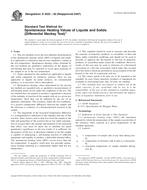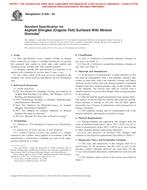1.1 This practice describes work practices for asbestos-cement products when maintenance, renovation and repair are required. This includes common tasks such as drilling and cutting holes in roofing, siding, pipes, etc. that can result in exposure to asbestos fibers if not done carefully.
1.2 Materials covered include those installed in or on buildings and facilities, and those used in external infrastructure such as water, wastewater and electrical distribution systems. Also included is pavement made from asbestos-cement manufacturing waste.
1.3 The work practices described herein are intended for use only with asbestos-cement products already installed in buildings, facilities and external infrastructure. They are not intended for use in construction or renovation involving the installation of new asbestos-cement products.
1.4 The work practices described herein are not intended for use where the primary objective is the removal of asbestos-cement products from the building or other location. The work practices are intended to be used in situations where small amounts of asbestos-cement products must be removed or disturbed in order to perform maintenance, renovation or repair necessary for operation of the building, facility or infrastructure.
1.5 The values stated in inch-pound units are to be regarded as the standard. The values given in parentheses are for information only.
1.6 Warning-Asbestos fibers are acknowledged carcinogens. Breathing asbestos fibers can result in disease of the lungs including asbestosis, lung cancer, and mesothelioma. Precautions in this standard practice should be taken to avoid creating and breathing airborne asbestos particles from materials known or suspected to contain asbestos. Comply with all applicable regulatory requirements addressing asbestos
1.7 This practice does not address safety hazards associated with working on asbestos-cement products such as falling through roof panels or trench cave-ins. The use of power tools presents possible electrical hazards, particularly in wet environments. These and other safety hazards must be considered and controlled in compliance with the employer’s policies and applicable regulations.
This standard does not purport to address all of the safety concerns, if any, associated with its use. It is the responsibility of the user of this standard to establish appropriate safety and health practices and determine the applicability of regulatory limitations prior to use.
Product Details
- Published:
- 10/01/2004
- Number of Pages:
- 17
- File Size:
- 1 file , 150 KB


